The Forestry Commission is a non-ministerial government department responsible for the management of publicly owned forests and the regulation of both public and private forestry in England.
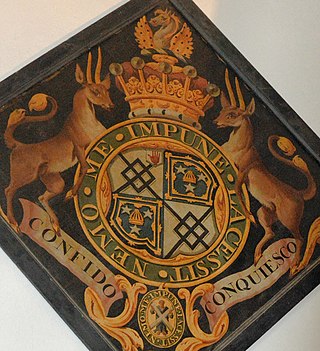
Earl of Dysart is a title in the Peerage of Scotland. It was created by King Charles I in 1643 for William Murray and has been held continuously since then by his descendants.
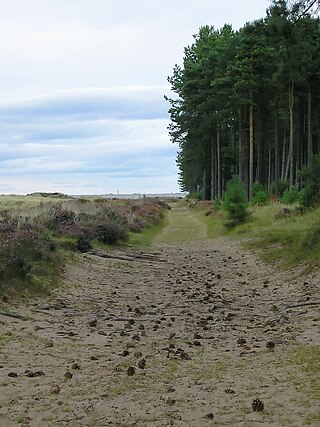
Tentsmuir Forest is in north east Fife, Scotland. Covering some 5 square miles (13 km2), the forest was originally sand dunes and moorland before acquisition by the Forestry Commission in the 1920s. The forest consists mainly of Scots pine and Corsican pine, and is now owned by Forestry and Land Scotland, successor body to the Forestry Commission.

The Caledonian Forest is the ancient (old-growth) temperate forest of Scotland. The forest today is a reduced-extent version of the pre-human-settlement forest, existing in several dozen remnant areas.

Glen Affric is a glen south-west of the village of Cannich in the Highland region of Scotland, some 15 miles west of Loch Ness. The River Affric runs along its length, passing through Loch Affric and Loch Beinn a' Mheadhoin. A minor public road reaches as far as the end of Loch Beinn a' Mheadhoin, but beyond that point only rough tracks and footpaths continue along the glen.

Glenmore Forest Park is a remnant of the Caledonian Forest near Aviemore in the Badenoch and Strathspey district of Highland, Scotland. Owned and managed by Forestry and Land Scotland, it lies within the Cairngorms National Park, and is one of six forest parks in the country. The forest park, which was established in 1948, covers 35.7 km2, of which 21.1 km2 is designated as a national nature reserve (NNR). Glenmore surrounds Loch Morlich, and is below the rise of the Cairngorms to the south; to the north the park extends to the summit of Meall a' Bhuachaille. The forest forms part of an expanse of Caledonian Forest that stretches from Glen Feshie to Abernethy, and which as a whole forms the largest single area of this habitat remaining in Scotland. It is home to much wildlife including Scottish crossbills, crested tits, capercaillie, narrow-headed ants, red squirrels and red deer.

Crimonmogate is an estate near Crimond, Aberdeenshire. The estate formed part of Lonmay parish, dates back to the 14th century, and was included in the lands owned by the powerful Earls of Erroll. The estate was sold by Mary Hay, 14th Countess of Erroll, in the 1730s.
Katherine Grant of Rothiemurchus, 12th Countess of Dysart was a Scottish peer.
The Dunecht Estate is one of the largest private estates in Aberdeenshire, Scotland at 53,000 acres (210 km2). It is owned by The Hon Charles Anthony Pearson, the younger son of the 3rd Viscount Cowdray. Dunecht's business interests include farming, forestry, field sports, minerals, let houses, commercial lets and tourism.
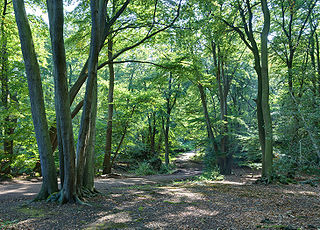
The United Kingdom, being in the British Isles, is ideal for tree growth, thanks to its mild winters, plentiful rainfall, fertile soil and hill-sheltered topography. In the absence of people, much of Great Britain would be covered with mature oaks, except for Scotland. Although conditions for forestry are good, trees do face damage threats arising from fungi, parasites and pests. The development of afforestation and the production and supply of timber in Wales come under Natural Resources Wales, as set out in the Forestry Act 1967.

Ardgoil is an estate in Argyll & Bute, Scotland. It is part of the Argyll forest park and is within the Loch Lomond and the Trossachs National Park. The Ardgoil estate is managed as part of the Argyll forest park by Forestry Commission Scotland. The Ardgoil estate is publicly owned land with the land title held for the public by the ministers of the Scottish Parliament. In the past the Ardgoil estate was also known as the city of Glasgow's Highland estate.

Scotland is ideal for tree growth, thanks to its mild winters, plentiful rainfall, fertile soil and hill-sheltered topography. As of 2019 about 18.5% of the country was wooded. Although this figure is well below the European Union (EU) average of 43%, it represents a significant increase compared to the figure of 100 years previously: in 1919 it was estimated that only 5% of the country's total land area was covered in forest. The Scottish Government's Draft Climate Change Plan has set an aim of increasing coverage to 21% of Scotland by 2032, with the rate of afforestation rising to 15,000 hectares per year by 2024.
John Peter Grant, 13th Earl of Dysart, styled Lord Huntingtower from 2003 to 2011, also known as Johnnie Grant, is a Scottish peer and landowner.

Dunwich Forest is an area of forest and lowland heath around 1 mile (1.6 km) north-west of the village of Dunwich in the English county of Suffolk. The forest covers an area of approximately 9 square kilometres and was originally planted by the Forestry Commission. The forest is within the Suffolk Coast and Heaths Area of Outstanding Natural Beauty and is in the area known as the Suffolk Sandlings. South of the reserve is the National Trust property of Dunwich Heath, one of the largest remaining areas of lowland heath on the Suffolk coast, and the RSPB reserve at Minsmere. To the north and east of the forest are Dingle Marshes, part of the Suffolk Coast National Nature Reserve.
Wenefryde Agatha Scott, 10th Countess of Dysart was a Scottish noblewoman.
Rosamund Greaves, 11th Countess of Dysart was a Scottish peer.

Argyll Forest Park is a forest park located on the Cowal peninsula in Argyll and Bute, Scottish Highlands. Established in 1935, it was the first forest park to be created in the United Kingdom. The park is managed by Forestry and Land Scotland, and covers 211 km2 in total.
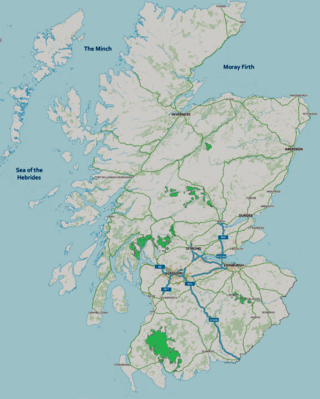
Forest parks are areas of forest managed by Forestry and Land Scotland (FLS) that are managed for multiple benefits, with an emphasis on recreation facilities for visitors. There are currently six forest parks in Scotland.
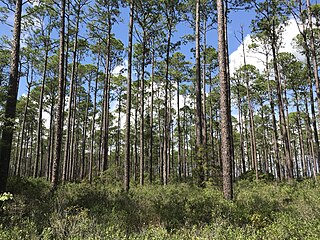
Dixon Memorial State Forest is a state forest in Brantley and Ware counties, located 10 miles southeast of Waycross, Georgia bordered by the Okefenokee National Wildlife Refuge to the south. The forest is approximately 35,000 acres and is the largest state forest owned and managed by the Georgia Forestry Commission. The forest is mostly made up of pine plantations consisting of slash pine, longleaf pine, and loblolly pine as well as wetlands consisting of pondcypress, swamp blackgum, sweetbay magnolia, loblolly bay, and other various hardwoods.

Forestry and Land Scotland (FLS) is responsible for managing and promoting Scotland's national forest estate: land, predominantly covered in forest, owned by the Scottish Government on behalf of the nation. It was formed on 1 April 2019, to take over some of the responsibilities of Forestry Commission Scotland, which was dissolved. The organisation exists alongside Scottish Forestry, also established on 1 April 2019, which is responsible for regulation, policy and support to landowners. Forestry and Land Scotland's key functions are to look after the national forest estate, including unforested land within this portfolio, and to produce and supply timber. Within this remit they are expected to enhance biodiversity, increase public access to the outdoors, encourage tourism and support the rural economy.














